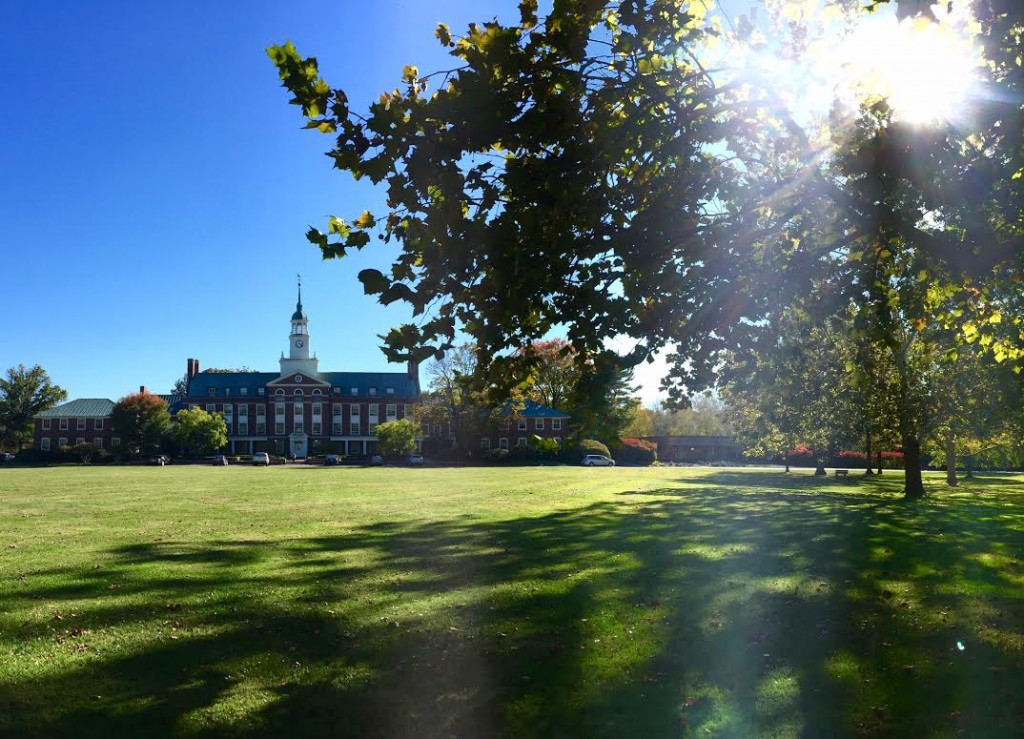
The Institute for Advanced Study in Princeton, NJ is one of many possible hosts for your math staycation. (Photo by Alexi Hoeft)
Thanksgiving is this week and the holidays are right around the corner, which means most of us will be getting several weeks off from formal grad school requirements. But the time off is good for much more than just plentiful eating, quality family time, and Netflix binge-watching (a verb which, if you missed it, was recently added to the dictionary). A fun holiday activity to add to the list: a math staycation! (Shockingly enough, this marvelous term [according to Google] is not yet in use.)
A math staycation consists of remotely (in space and/or time) attending a math conference by watching the video lectures from the convenience of wherever you might find yourself during the holidays.
After deciding that this sounds like the most exciting use of your holiday time that you ever could have imagined, the first step toward planning your math staycation is choosing the math conference that you want to follow. The quantity, quality, and variety of recorded conferences has skyrocketed in the last decade, and you will likely have many more good candidate workshops than time allows.
There are two main styles of math staycation:
- video combo plate (custom-build a playlist of math video lectures/recorded seminars that are of interest to you, even if they originate from different conferences) and
- traditional conference entrée (watch an entire conference more or less in its entirety and in the original order).
Search for your math staycation materials using Google or begin with the extensive lists I’ve gathered for you below:
- MSRI in Berkeley, CA has been recording their workshops and summer schools for over a decade now, and the lectures feature world-class mathematicians speaking on an incredible multitude of topics. The above link is the official MSRI video page, but you may want to narrow your search by instead searching Google for “MSRI” followed by the main keywords in your field.
- Banff International Research Station records the video lectures of their exclusive (invitation-only) math research weeks which take place tucked away in the mountains of Canada.
- The Fields Institute in Toronto boasts an impressive archive of recorded conference lectures, and some of the videos feature a useful interactive zoom and pan capability so you get to control which part of the board or slide that you see.
- The Institute for Advanced Study in Princeton has quite the extensive archive of video lectures in mathematics (in addition to other subjects studied at the IAS). Their archive is particularly useful for the “combo plate” approach of the math staycation. (Note the useful search bar in the upper-right corner of the page.)
- (Suggested by commenter) The CIRM in Marseilles, France hosts an AV library of recorded math talks from their research center (and here the videos are conveniently sorted by subject area) and also has a YouTube channel called CIRMChannel with interviews in addition to the lectures. The lectures and a fair number of the interviews are in English.
- A growing number of math departments at universities across the country and around the globe offer their own pages of recorded math talks, e.g. this page by Stony Brook’s math department.
Next, you will want to plan your math staycation (to ensure it actually happens). Set aside about a week of time for your staycation. Schedule your staycation for a quieter portion of your holiday season, e.g. after the New Year if that is when you might have a bit more uninterrupted time to yourself. Mark it in your calendar to help make it psychologically “official” that you are “attending” the conference. If you also want more guidance on the day-to-day schedule of your math staycation, feel free to use as a guide the posted program on the corresponding conference site or that of a similar conference.
If you thrive with accountability, you can use these last remaining weeks of the semester to find one or two graduate students in your area of interest who might want to embark on a math staycation with you; your group could maintain an email chain throughout the math staycation to help everyone stay connected and engaged. You could even choose students outside your field and mutually commit to presenting what you learned from the math staycation to one another over lunch soon after the holidays are over. Alternatively, you can sign yourself up to give a talk next semester through one of the graduate student seminar series at your department in order to give yourself a focused goal during your math staycation.
Are there other great web pages of archived math conference videos that you would recommend? Have you chosen your math staycation? Leave a comment below!
I hope you enjoy your math staycation, and come back after break to let us know how it all went!

If you too are considering a Great Math Staycation, don’t forget to check out CIRM’s AV Maths library http://library.cirm-math.fr/Main.htm?context=2&lang=en and also CirmChannel on Youtube (research talks, interviews, etc.)
Thank you 😉
www.cirm-math.fr
Merci beaucoup, Madame Vareilles! The CIRM hosts fantastic math talks, and it’s such a great resource to have the talks so nicely gathered like this in the AV library and on the CIRMChannel on YouTube! I have added them to the resource list in the post.